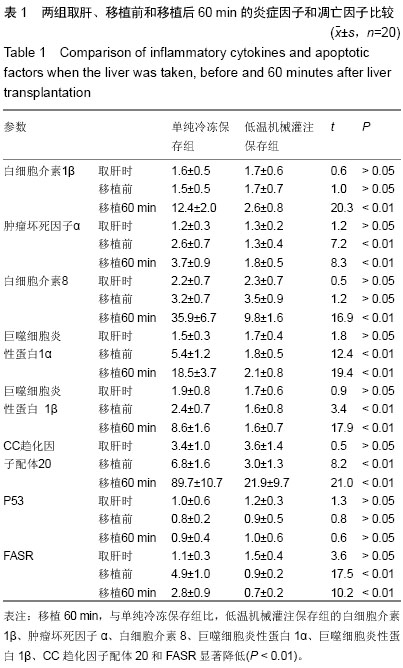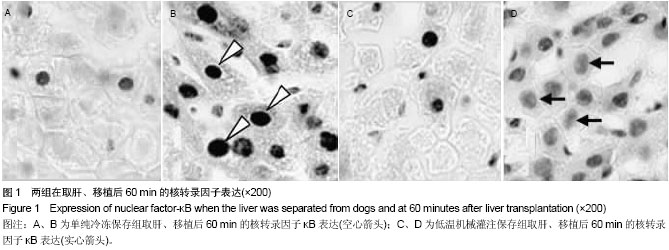| [1] 王彦军.低温保存家兔同种异体血管移植的实验研究[D].郑州大学,2014.
[2] 郑章强,朱志军.肝脏低温机械灌注保存的研究进展[J],实用器官移植电子杂志,2013,1(2):120-132.
[3] 赵子粼,张云生,俞金龙,等.肝移植用保存液[J].世界华人消化杂志,2001,9(1):77-79.
[4] Moers C,Smits JM,Maathuis MH,et al. Machine perfusion or cold storage in deceased-donor kidney transplantation.N Engl J Med.2009;360(14):7-19.
[5] Bae C,Henry SD,Guarrera JV.Is extracorporeal hypothermic machine perfusion of the liver better than the 'good old icebox'? Curr Opin Organ Transplant.2012;17(2):137-142.
[6] Morino M,Adam R,Diamond T,et al.Effect of storage temperature on early graft function folllwing liver transplantationp. Clin Transplant.1992;6(2):97-99.
[7] Merion RM,Goodrich NP,Feng S. How can we define expanded criteria for liver donors?. J Hepatol.2006;45(4):484-488.
[8] Tolboom H,Milwid JM,Izamis ML. Sequential cold storage and normothermic perfusion of the ischemic rat liver. 2008;40(5): 1306-1309.
[9] Guarrera JV,Henry SD,Samstein B,et al. Hypothermic machine preservation in human liver transplantation: The first clinical series.Am J Transplant 2010;32(10): 372-381.
[10] Schlegel A, Kron P, Graf R,et al.Hypothermic Oxygenated Perfusion (HOPE) downregulates the immune response in a rat model of liver transplantation. Ann Surg.2014;260(5):931- 937.
[11] Busuttil RW,De Carlis LG,Mihaylov PV,et al. The First Report of Orthotopic Liver Transplantation in the Western World.Am J Transplant.2012;12(6):1385-1387.
[12] Henry SD,Guarrera JV. Protective effects of hypothermic ex vivo perfusion on ischemia/reperfusion injury and transplant outcomes.Transplant Rev (Orlando).2012;26(2):163-175.
[13] 余宏铸,樊嘉禄.对我国肝移植现状的系统化思考[J].医学与哲学, 2001,22(6):4-7.
[14] 王露佳,孙雯,张金萍,等.自制移植肝低温保存液对氧自由基的影响[J].中国组织工程研究,2013,17(5):837-842.
[15] Matsuno N, Obara H, Watanabe R, et al.Rewarming preservation by organ perfusion system for donation after cardiac death liver grafts in pigs. Transplant Proc. 2014;46(4): 1095-1098.
[16] Hirano F, Komura KJ, Fukawa E, et al. Tumor necrosis factor-α( TNF-α) induced RANTES chemokine expression via activation of NF-κB and p38 MAP kinase: roles of TNF-α in alcoholic liver diseases. J Hepatol.2003;38 (4): 483-489.
[17] 李梦娟.吡格列酮对2型糖尿病大鼠肝脏及NF-κB、MCP1表达的影响[D].安徽医科大学,2012.
[18] Schlegel A, Graf R, Clavien PA,et al.Hypothermic oxygenated perfusion (HOPE) protects from biliary injury in a rodent model of DCD liver transplantation. J Hepatol.2013;59(5):984-91.
[19] Monbaliu D, Heedfeld V, Liu Q, et al.Hypothermic machine perfusion of the liver: is it more complex than for the kidney? Transplant Proc. 2011;43(9):3445-3450.
[20] Jia JJ, Li JH, Jiang L,et al.Liver protection strategies in liver transplantation. Hepatobiliary Pancreat Dis Int.2015;14(1): 34-42.
[21] Van Caenegem O, Beauloye C, Vercruysse J,et al. Hypothermic continuous machine perfusion improves metabolic preservation and functional recovery in heart grafts. Transpl Int.2015;28(2):224-231
[22] 林健清,林群,林财珠.丙泊酚对大鼠移植肝NFκB活化、ICAM1、IL-1β和TNF-α表达的影响[J].临床麻醉学杂志,2009,25(8): 695-697.
[23] 罗刚健,池信锦,张瑷兰,等.大鼠自体原位肝移植肺组织TNF-α、IL-1β和IL-6的表达[J].中山大学学报:医学科学版,2012,33(7): 444-448.
[24] 周杰斌.大鼠肝移植缺血再灌注损伤中TNFα、IL1的表达及银杏叶提取物的预处理效用[D].中南大学,2006.
[25] Gottlieb AB,Chamian F,Masud S,et al. TNF inhibition rapidly down-regulates multiple proinflammatory pathways in psoriasis plaques. J Immunol.2005;175(4):2721-2729.
[26] Guarrera JV, Henry SD, Chen SW, et al.Hypothermic machine preservation attenuates ischemia/reperfusion markers after liver transplantation: preliminary results. J Surg Res. 2011; 167(2):e365-73.
[27] Tozzi M, Franchin M, Soldini G,et al.Impact of static cold storage VS hypothermic machine preservation on ischemic kidney graft: inflammatory cytokines and adhesion molecules as markers of ischemia/reperfusion tissue damage. Our preliminary results.Int J Surg.2013;11(Suppl 1):S110-114.
[28] Tulipan JE, Stone J, Samstein B,et al.Molecular expression of acute phase mediators is attenuated by machine preservation in human liver transplantation: preliminary analysis of effluent, serum, and liver biopsies. Surgery. 2011;150(2):352-360.
[29] Gomez-Lechon MJ,Serralta A,Donato MT. The immunosuppressant drug FK506 prevents Fas-induced apoptosis in human hepatocytes. Biochem Pharmacol. 2004; 68(12):2427-2433.
[30] Liu W, Lin YT, Yan XL,et al.Hepatitis B virus core protein inhibits Fas-mediated apoptosis of hepatoma cells via regulation of mFas/FasL and sFas expression. FASEB J. 2015;29(3):1113-1123.
[31] Miyagawa-Hayashino A,Tsuruyama T,Egawa H,et al. FasL expression in hepatic antigen-presenting cells and phagocytosis of apoptotic T cells by FasL+ Kupffer cells are indicators of rejection activity in human liver allografts. Am J Pathol.2007;171(5):1499-1508. |

